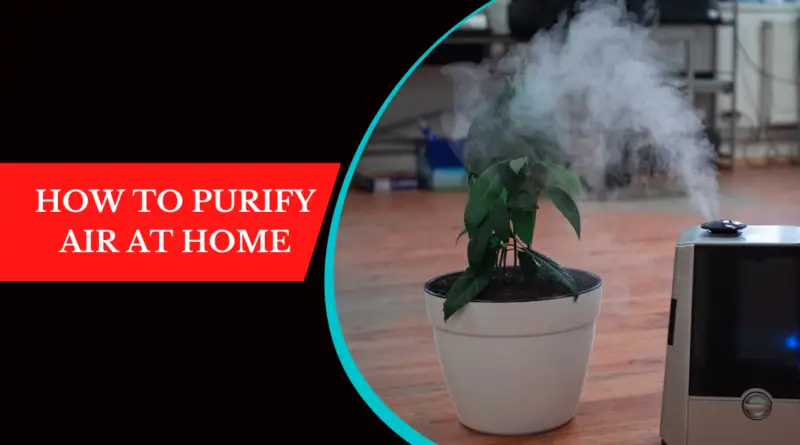How to Purify Air at Home
The air we breathe indoors can be surprisingly polluted, often containing dust, allergens, pet dander, and even harmful chemicals. These pollutants can irritate allergies, exacerbate respiratory problems, and affect overall well-being. But fear not! There are numerous effective steps you can take to purify the air in your home and create a healthier living environment.
Understanding Indoor Air Pollution
Before diving into solutions, let’s explore the common culprits contributing to indoor air pollution:
Outdoor Pollutants: Smoke, dust, and pollen can infiltrate your home through windows and doors.
Household Products: Cleaning chemicals, air fresheners, and even fragranced candles emit volatile organic compounds (VOCs) that pollute the air.
Building Materials: Carpets, furniture, and paints can release harmful chemicals, especially in new homes.
Mold and Mildew: Damp environments encourage mold and mildew growth, releasing spores that trigger allergies and respiratory problems.
Pets: Animal dander and fur can irritate allergies and contribute to dust.
Simple Steps to Purify Air at Home

Identify Air Pollutants: Before you can effectively purify the air in your home, it’s essential to understand the common sources of indoor air pollution. These may include dust, pet dander, pollen, mold spores, smoke, volatile organic compounds (VOCs) from household products, and indoor allergens.
Keep Your Home Clean: Regular cleaning is one of the most basic yet crucial steps to maintain good indoor air quality. Vacuum carpets, rugs, and upholstery frequently to remove dust and allergens. Dust surfaces, mop floors, and clean bedding regularly to reduce the buildup of dirt and allergens.
Improve Ventilation: Proper ventilation is essential for reducing indoor air pollutants and maintaining fresh air circulation. Open windows and doors whenever possible to allow fresh air to enter your home. Use exhaust fans in the kitchen and bathroom to remove cooking fumes, moisture, and odors.
Invest in Air Purifiers: Air purifiers are highly effective devices designed to remove airborne contaminants and improve indoor air quality. Choose an air purifier with a HEPA (High-Efficiency Particulate Air) filter, which can capture particles as small as 0.3 microns with high efficiency. Place the air purifier in commonly used rooms, such as the living room or bedroom, for optimal results.
Use Indoor Plants: Certain indoor plants have natural air-purifying properties and can help remove toxins from the air. Consider adding plants such as spider plants, peace lilies, snake plants, and Boston ferns to your home decor. These plants not only enhance indoor air quality but also add beauty and greenery to your living space.
Control Humidity Levels: Maintaining appropriate humidity levels in your home is essential for preventing mold growth and improving indoor air quality. Use a dehumidifier in damp areas such as basements to reduce excess moisture. In dry climates, consider using a humidifier to add moisture to the air and prevent respiratory discomfort.
Avoid Smoking Indoors: Tobacco smoke is a major indoor air pollutant that can have serious health effects on both smokers and non-smokers. If you or someone in your household smokes, make a commitment to smoke outdoors only. Establishing a smoke-free environment indoors is crucial for protecting the health of your family members.
Minimize Chemical Exposure: Many household products, such as cleaning agents, air fresheners, and pesticides, contain harmful chemicals that can pollute indoor air. Opt for natural and eco-friendly alternatives whenever possible, or use products with low VOC (volatile organic compound) emissions. Properly ventilate areas when using chemical-based products, and store them securely to prevent exposure.
Change Air Filters Regularly: If your home has central heating, ventilation, and air conditioning (HVAC) systems, ensure that air filters are clean and replaced regularly. Dirty air filters can restrict airflow and allow pollutants to circulate throughout your home. Follow the manufacturer’s recommendations for filter replacement intervals to maintain optimal indoor air quality.
Test for Radon and Carbon Monoxide: Radon and carbon monoxide are invisible, odorless gases that can pose serious health risks if present in high concentrations indoors. Consider testing your home for radon and installing carbon monoxide detectors to ensure a safe living environment for you and your family.
Conclusion: Breathe Deeply, Live Healthier
By implementing these steps, you can significantly improve the air quality in your home, creating a healthier and more comfortable living environment. Remember, consistency is key. By making these practices part of your routine, you’ll breathe easier, knowing you’re providing a clean and healthy space for yourself and your loved ones.



